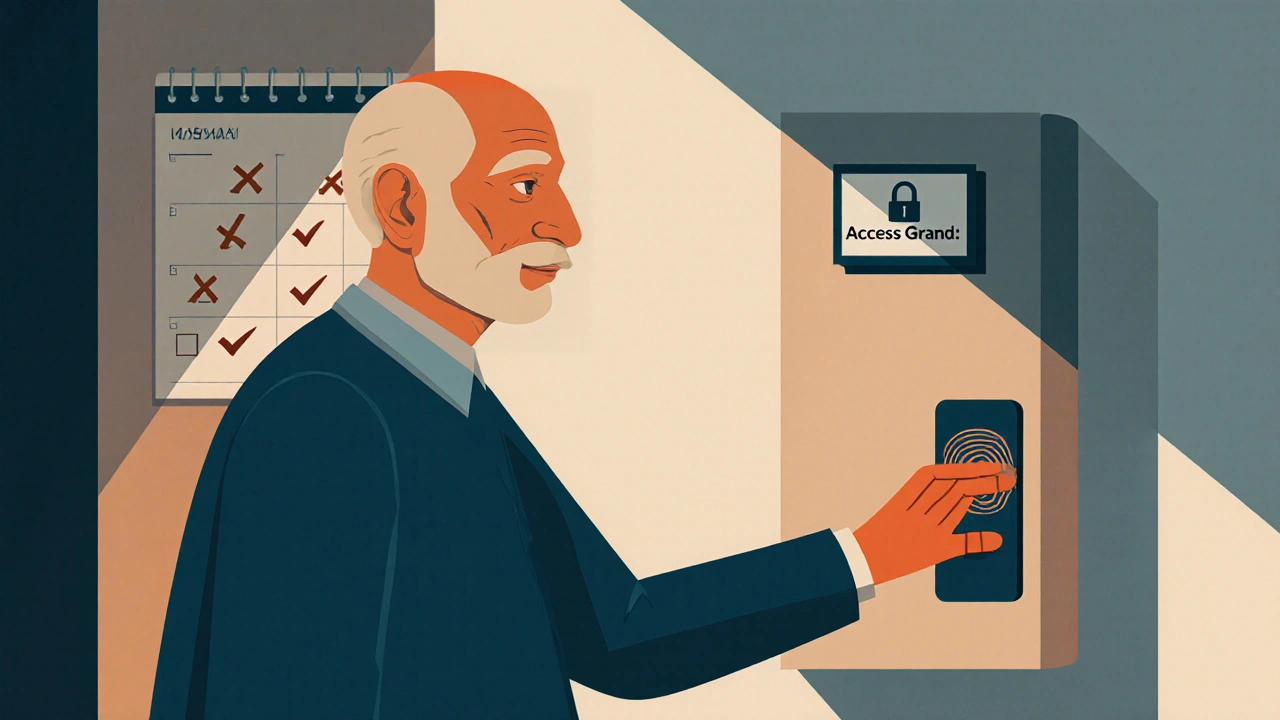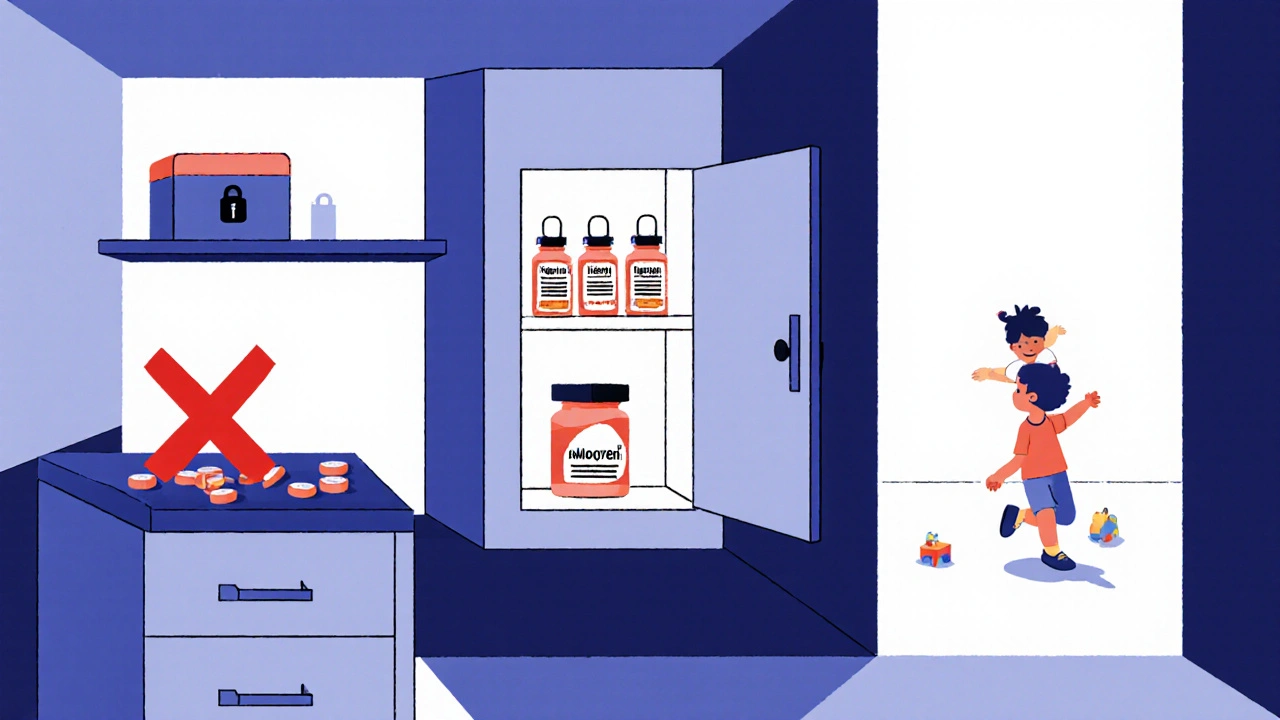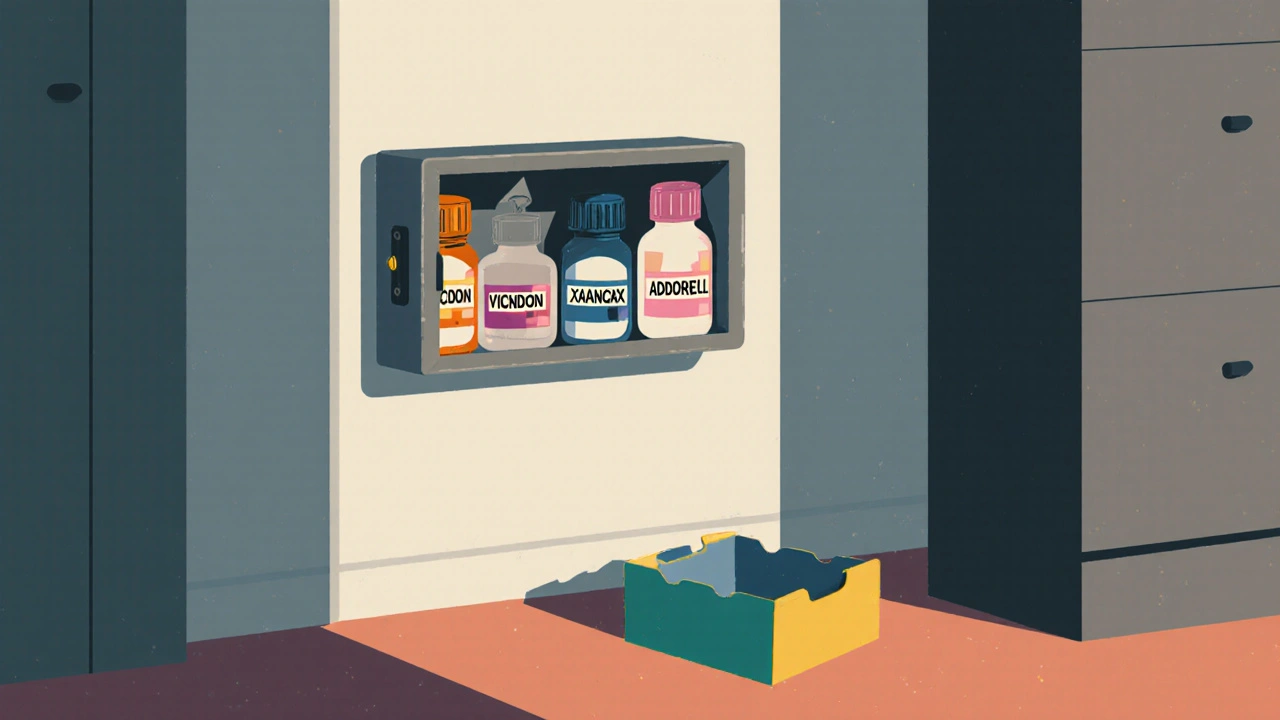Every year, 60,000 children end up in the emergency room because they got into medications left out in the open. Most of these cases aren’t accidents caused by carelessness-they’re the result of simple, preventable mistakes. A child finds a bottle on a nightstand. A teenager grabs pills from a bathroom cabinet. A visitor takes a few pills "just to help with pain." These aren’t rare events. They’re common. And they’re preventable.
If you keep opioids, benzodiazepines, or stimulants at home-medications like Vicodin, Xanax, or Adderall-you need more than child-resistant caps. You need a lockbox.
Why Lockboxes Are Non-Negotiable
Child-resistant caps aren’t enough. A CDC study found that half of all kids aged 4 to 5 can open them in under a minute. Hidden spots? Kids find them. A 2023 Hennepin Healthcare report showed 72% of children locate "hidden" meds within 30 minutes. Even if you think your home is "safe," the data doesn’t lie: households using lockboxes saw a 92% improvement in safe storage practices compared to those relying on caps or hiding pills.
The risk isn’t just about kids. Opioid misuse by teens, roommates, or even visiting family members is a real threat. In 2021, over 16,700 overdose deaths in the U.S. involved prescription opioids. Lockboxes don’t just protect children-they protect your whole household.
What Counts as a High-Risk Medication?
Not every pill needs a lockbox. But these do:
- Opioids: Hydrocodone (Vicodin, Norco), Oxycodone (Percocet, OxyContin), Fentanyl patches
- Benzodiazepines: Alprazolam (Xanax), Diazepam (Valium), Clonazepam (Klonopin)
- Stimulants: Dextroamphetamine-amphetamine (Adderall), Methylphenidate (Ritalin)
These drugs are highly addictive and deadly in small doses. Even one missing pill can be dangerous. If you’re unsure, check the label. If it’s a controlled substance (usually marked with a C-II, C-III, or C-IV), it belongs in a lockbox.
Choosing the Right Lockbox
Lockboxes aren’t all the same. Here’s what to look for:
- Size: For one person’s short-term meds, a 6x4x3 inch box works. For a family’s supply or long-term prescriptions, go for 12x8x6 inches.
- Lock type: Key locks are simple but risk losing the key. Combination locks (3-4 digits) are common but can be forgotten. Biometric (fingerprint) models cost more but eliminate both problems-ideal for households with elderly users or multiple authorized people.
- Material: Look for reinforced steel or heavy-duty ABS plastic. Many are fire-resistant up to 1,700°F for 30 minutes, which matters if you live in an area prone to fires.
- Climate control: If you store insulin or other refrigerated meds, get a lockbox with a built-in cooler. Regular lockboxes aren’t temperature-controlled.
- Mounting: Wall-mounted models prevent kids from moving or tipping them over. Some even come with anchors for drywall or wood.
GoodRx reports that 68% of top-rated lockboxes use steel or reinforced plastic. Avoid flimsy plastic boxes labeled "medication organizer"-they’re not locks, just containers.
Where to Place Your Lockbox
Location matters as much as the lock itself. Here’s what works:
- Best spots: Inside a bedroom closet, on a high shelf in a home office, or mounted on a wall in a rarely used room.
- Avoid: Bathrooms (too humid), kitchen counters (too visible), nightstands (too easy to reach), and living rooms (too accessible to guests).
- Pro tip: Don’t put it near the medicine cabinet. That’s where people look first. Put it somewhere unexpected but easy for you to access daily.
According to Hennepin Healthcare, 62% of failed lockbox setups happened because people placed them in obvious or reachable spots. A lockbox on the floor near a child’s toy box? That’s not a lockbox-it’s a challenge.

How to Set It Up Correctly
Follow this 5-step protocol from the CDC’s 2022 guidelines:
- Identify all high-risk meds: Go through every drawer and cabinet. Remove every opioid, benzo, and stimulant. Put them in a temporary bag.
- Pick the right box: Match size and lock type to your household. Biometric is best if anyone has arthritis or memory issues.
- Choose the location: Secure, dry, out of sight, but easy for authorized users. Don’t forget to anchor it if it’s wall-mounted.
- Set access rules: Only one or two adults should know the code or have the key. Never give it to teens, guests, or babysitters-even if they’re "trusted."
- Verify weekly: Check that all meds are still inside. If someone’s prescription ran out, remove the empty bottle. If a new one came in, add it.
Most people get the hang of it in 2-3 days. The hardest part? Remembering to put the meds back after taking them. Make it a habit-like locking your front door.
What About Elderly Users or People With Limited Dexterity?
This is the biggest complaint. A 2022 JAMA Internal Medicine study found that 15% of adults over 75 struggle with combination locks or small keys. If you or a loved one has shaky hands, arthritis, or memory loss, don’t give up-just upgrade.
Biometric lockboxes are the solution. They open with a fingerprint, no buttons, no codes, no keys. Brands like Master Lock and Safe Keeper offer models under $40. Yes, they cost $10-$35 more than basic locks-but that’s less than one prescription refill. And they’re worth it. One Reddit user, u/CaregiverAnne, switched her 80-year-old father from a combo lock to a fingerprint box and said: "He hasn’t missed a dose since. I don’t have to help him open it every morning. That’s peace of mind."
What to Do If You Can’t Afford One
Free lockboxes are available in at least 22 states. Programs like South Dakota’s "Let’s Be Clear SD" and the national "Locks Save Lives" campaign give them away for free to anyone who asks. Many pharmacies, hospitals, and community health centers also distribute them.
Call your local health department or search: "free medication lockbox + [your state]." If you’re on Medicare or Medicaid, ask your case manager. Most programs have no income requirements.
If you can’t get one for free, a basic combination lockbox costs as little as $15 online. It’s cheaper than a single ER visit.

What Happens When the Prescription Ends?
Don’t just toss empty bottles in the trash. Unused pills can still be dangerous.
- Use a drug take-back program. Many pharmacies, police stations, and hospitals have drop boxes.
- If none are nearby, mix pills with coffee grounds or cat litter, seal them in a bag, and throw them in the trash. Never flush them.
- Remove the label from the bottle before recycling it.
And once the meds are gone, keep the lockbox. You never know when another prescription might come. It’s like a smoke detector-you don’t remove it after the first alarm.
Real Stories, Real Results
u/MedSafetyMom on Reddit: "After my 3-year-old almost got to my fentanyl patch, I bought a Master Lock box. Eight months later? Zero incidents. I sleep better now. I wish I’d done it sooner."
Another parent: "I thought my teen was responsible. Then I found a half-empty bottle of Xanax in his backpack. That’s when I installed the lockbox. He complained for a week. Now he says it’s "cool" because he doesn’t have to lie about where his meds are."
Consumer Reports surveyed 1,200 households. 78% said they felt "much safer" after installing a lockbox. Only 22% said it was inconvenient-and most of those were people who kept forgetting the code.
What’s Next? Smart Lockboxes and the Future
The FDA approved the first smart lockbox in May 2023: the MediVault Pro. It records every time someone opens it and sends alerts to a phone if an unauthorized access happens. The National Institute on Drug Abuse is funding research into fingerprint-verified dispensers that only release the exact dose prescribed-no extra pills, no temptation.
Starting in January 2024, new homes built under the "Healthy Home" certification standard must include a designated space for a medication lockbox. This isn’t a trend-it’s becoming standard practice.
You don’t need to wait for the future. Start today. A $20 lockbox could be the thing that keeps your child alive, your teen from getting addicted, or your partner from accidentally overdosing.
Final Checklist
Before you close this page, ask yourself:
- Do I have any opioids, benzodiazepines, or stimulants at home?
- Are they stored in a locked box-not just a cabinet or drawer?
- Is the lockbox out of reach of children and teens?
- Do only two people know the code or have the key?
- Have I checked the box this week to make sure nothing’s missing?
If you answered "no" to any of these, take five minutes right now. Find the lockbox. Put the meds in it. Lock it. You’ve just done something that could save a life.
Can I just use a locked drawer instead of a lockbox?
A locked drawer is better than nothing, but it’s not as reliable. Lockboxes are designed specifically for medication safety-they’re smaller, harder to pry open, and often fire-resistant. A drawer can be forced open, and if it’s not anchored, a child can pull it out. A lockbox is a dedicated safety tool. Use it.
What if I forget the combination to my lockbox?
Most lockboxes have a reset procedure-check the manual. If you lost it, call the manufacturer. Many offer a master reset code if you register your product online. For older models, you may need to contact customer service with proof of purchase. To avoid this, write the code down and store it in a separate secure place, like your wallet or a safety deposit box.
Do I need a lockbox if I don’t have kids at home?
Yes. Even if you live alone, someone else might visit-family, friends, houseguests, or even a service worker. Prescription drugs are often stolen for resale or personal use. A lockbox prevents opportunistic theft. It’s not just about children-it’s about control over your own medication.
Can I store all my medications in one lockbox?
You can, but it’s better to separate them. Keep high-risk meds (opioids, benzos, stimulants) in the lockbox. Store everyday meds like ibuprofen or allergy pills outside. This makes it easier to find what you need quickly and reduces the chance of someone grabbing the wrong bottle. Plus, if someone needs an over-the-counter pain reliever, they won’t have to break into the lockbox.
Are there any legal requirements to use a lockbox?
As of 2023, 14 states require locked storage for opioid prescriptions in homes with minors. While not all states have laws yet, healthcare providers are legally required to discuss safe storage with patients. In many cases, failing to store opioids securely can be seen as negligence if harm occurs. Using a lockbox isn’t just smart-it’s becoming a legal expectation.
